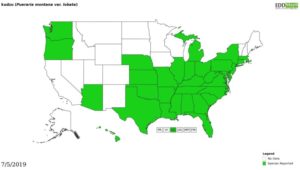If you have lived in the South for awhile, you have heard the word “kudzu”. It’s scientific name is Pueraria montana var. lobata(Willd.) Maesen & S. M. Almeida ex Sanjappa & Predeep. Kudzu is easier.
Kudzu started innocently enough. It showed up at a couple of expos from Asia and Europe in the late 1800s. Then, Southerners found it as a great ornamental shade for their porches.See, kudzu is a fast growing, thick, trailing and climbing perennial vine. It doesn’t need great soil and spreads quickly. Too quickly as many were to find out.
See kudzu roots can grow as deep as 12 feet. And most scientists agree that it can grow on average a foot a day. By the early 1900s you could buy kudzu in seed catalogs. And when the Dust Bowl hit in the 1930s, 85 million kudzu plants were distributed by the Soil Erosion Service to Southern landowners to help prevent erosion.It made sense as kudzu doesn’t stress during drought. By 1946, 3 million acres of kudzu had been planted in the South.
That’s when the trouble started in the 50s. Farmers were leaving for higher paying jobs. Suddenly the kudzu was allowed to run rampant. By the 60s, kudzu was no longer distributed by the government. In the 70s , it was officially listed as a weed. In 1997 it was put on the Federal Noxious Weed list.
Kudzu isn’t just fast growing, it also chokes out all vegetation and especially timber it grows or climbs on. While pretty, it is also deadly. To date 33 states have official reports of major kudzu coverage.

What To Do Now
Today, almost 7 million acres of kudzu cover land in the Southeast alone. But, how can we stop it? Invasive insects and blight have been tried, but, you have to be careful with those, or otherwise you have a whole new problem. Herbacides are an option, but, that’s not a very popular alternative.
So, we turn to our 4-legged friends. Kudzu is actually great forage for animals, with many benefits. But, it’s not a long term solution as a animal food alternative, because defoliation after 3-4 years kills off the stand. A small heard of goat or sheep can pretty much mow down and acre of kudzu each day.
If you would like to see various treatments and preventative measures click here
Eat It!!!!!
That’s right y’all! Kudzu is a-ok for humans. 3 parts of the plants are edible:
- Young Leaves and Vine Tips
- Flowers
- Roots
First and foremost- Do some research and know the difference between poison oak and ivy and kudzu. They look similar.
For ideas from teas to salads to boiled recipes click here




